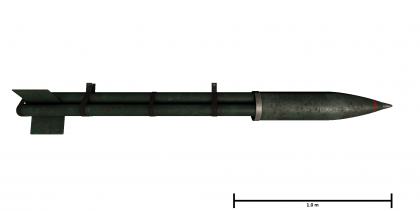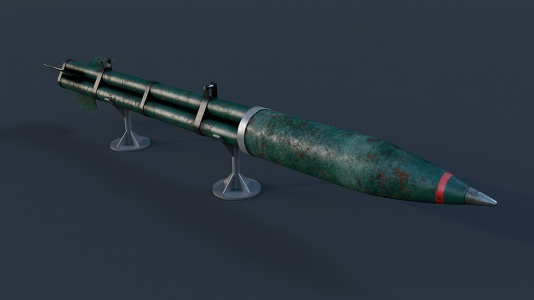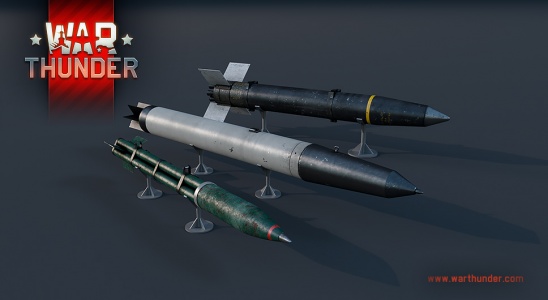Difference between revisions of "Triplex R.P."
RaulTejada2 (talk | contribs) (→Vehicles equipped with this weapon) (Tag: Visual edit) |
Indo_Pilot (talk | contribs) (Added Sea Fury FB 51) |
||
| (One intermediate revision by one other user not shown) | |||
| Line 3: | Line 3: | ||
[[File:WeaponImage Triplex R.P.png|thumb|left|420px|The Triplex R.P. rocket (scale is approximate)]] | [[File:WeaponImage Triplex R.P.png|thumb|left|420px|The Triplex R.P. rocket (scale is approximate)]] | ||
{{Break}} | {{Break}} | ||
| − | The Triplex R.P. is an unguided, high-explosive rocket developed by the British in the mid to late 1940s. It is a development of the ubiquitous [[RP-3]] rocket. It was first added in the [[Update | + | The Triplex R.P. is an unguided, high-explosive rocket developed by the British in the mid to late 1940s. It is a development of the ubiquitous [[RP-3]] rocket. It was first added in the [[Update "Starfighters"]]. |
=== Vehicles equipped with this weapon === | === Vehicles equipped with this weapon === | ||
| Line 9: | Line 9: | ||
* {{Specs-Link|sea_fury_fb11}} | * {{Specs-Link|sea_fury_fb11}} | ||
| + | * {{Specs-Link|sea_fury_fb51}} | ||
* {{Specs-Link|spitfire_f22}} | * {{Specs-Link|spitfire_f22}} | ||
* {{Specs-Link|spitfire_f24}} | * {{Specs-Link|spitfire_f24}} | ||
| Line 28: | Line 29: | ||
| '''TNT equivalent''' || 12.7 kg | | '''TNT equivalent''' || 12.7 kg | ||
|- | |- | ||
| − | | | + | | '''Penetration''' || 63 mm |
| − | |||
| − | |||
| − | |||
| − | | | ||
| − | |||
| − | |||
| − | |||
| − | |||
| − | |||
| − | |||
| − | |||
|- | |- | ||
|} | |} | ||
Latest revision as of 13:52, 18 October 2024
Contents
Description
The Triplex R.P. is an unguided, high-explosive rocket developed by the British in the mid to late 1940s. It is a development of the ubiquitous RP-3 rocket. It was first added in the Update "Starfighters".
Vehicles equipped with this weapon
General info
| Rocket characteristics | |
|---|---|
| Mass | 139 kg |
| Maximum speed | 245 m/s |
| Explosive mass | 12.7 kg |
| Explosive type | Amatol |
| TNT equivalent | 12.7 kg |
| Penetration | 63 mm |
The Triplex R.P. is an assembly of three RP-3 engines clamped together behind an explosive warhead, with three larger fins replacing the four typically found on each RP-3. The whole rocket weighs 139 kg. Its engines propel the rocket and its 12.7 kg TNT payload at a maximum speed of 245 m/s. The Sea Fury can carry four of these rockets at a time. They are fired individually, with the order being outer left, outer right, inner left, inner right. This is important to remember for rockets, since the position on the wing will affect the trajectory. The Triplex rockets are powerful tank-busters and can easily destroy ground targets in Air Battle as well.
Effective damage
The Triplex carries a Semi-Armour Piercing (SAP) warhead (similar to the RP-3) with 12.7 kg of explosive filler. The high explosive power on its own can penetrate an astounding 63 mm of armor at any range and angle. This makes it an extremely potent anti-tank weapon, and the sheer size of the warhead will help ensure tank knock-outs that an ordinary RP-3 might not be able to achieve.
Comparison with analogues
- S-21 - The Triplex outperforms the S-21 in explosive mass, and has 63 mm of penetration versus the S-21's 62 mm. However, the S-21 has a significantly higher velocity of 385 m/s versus the 245 m/s of the Triplex.
- Uncle Tom - The Uncle Tom rocket is similar to the Triplex. It flies at the same 245 m/s velocity. However, the Uncle Tom has around 50 kg of explosive mass compared to the 12.7 kg of the Triplex. The other significant differences include its weight and what vehicles it can be used on.
- Red Angel - The Red Angel is similar to the Uncle Tom rocket, however, it has less explosive mass and is exclusive to the Wyvern S4.
Usage in battles
The Triplex is a devastating rocket capable of destroying hard targets up to pillboxes in Air Battle. In Ground Battles, a well-aimed Triplex rocket will shred through the roof of any tank the Sea Fury can encounter at its BR. The explosive power of the Triplex can penetrate 63 mm of armor at any angle, allowing for more lenience in the angle of attack than other rockets like the RP-3. And, with almost 2.5x the explosive mass of the RP-3, you can safely expect the Triplex to inflict significant damage. While the explosive yield is strong, a direct hit on the weak points of an enemy tank is still required to ensure destruction.
Pros and cons
Pros:
- More lenient than the RP-3 rocket at angles, with a higher overall penetrating power than even the best conditions for the RP-3.
- Sizable explosive mass will inflict significant damage to targets regardless of whether the SAP warhead penetrated the armor.
- If the warhead does get through the armor, it is nigh-on guaranteed to destroy whatever it hits.
- More aerodynamic and lighter overall than the RP-3 loadout for the Sea Fury.
- Good aim will ensure consistent one-shot knock-outs against just about any opponent in the Sea Fury's BR bracket.
Cons:
- Carrying capacity of four can be low for players with less experience.
- Has even less velocity than the already sluggish RP-3.
- Like the RP-3, the warhead fuse is very sensitive.
- Restricted to be used on only one vehicle.
History
The Triplex R.P.'s developmental history is largely obscure. What is known is that the rocket was developed, produced, and mounted on the Hawker Sea Fury sometime before the start of the Korean War. The Hawker promotional brochure for the Sea Fury mentions the rockets by name as the "Triplex R.P., 180 lb. (82 kg) head"[1]. During the Korean War, due to complications with carrier operation, the Sea Fury typically employed rockets in its ground strike missions[2]. However, in late 1950 - early 1951, the British Admiralty issued an order that the Sea Fury's maximum rocket load while carrying drop tanks, which was most of the time during the conflict, would be reduced to only four rockets due to the harsh conditions of the Yellow Sea[2]. Presumably, the Triplex would be too heavy to be carried under these restrictions. If the Triplex saw use, it would have been limited at best.
Media
- Images
See also
External links
References






